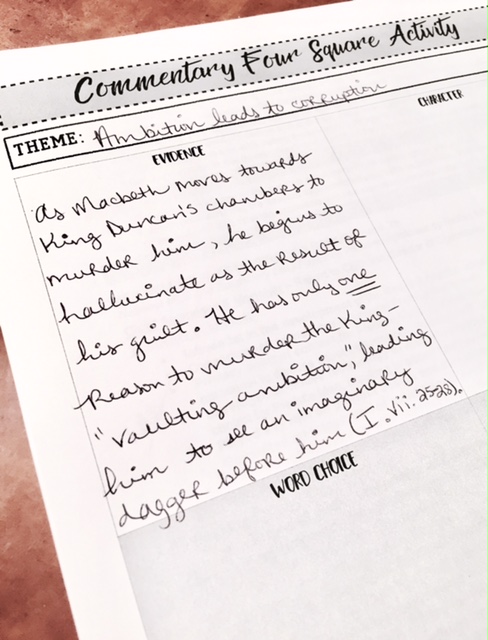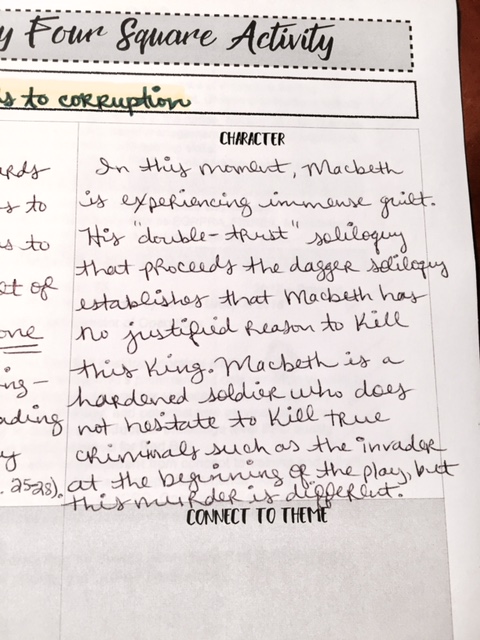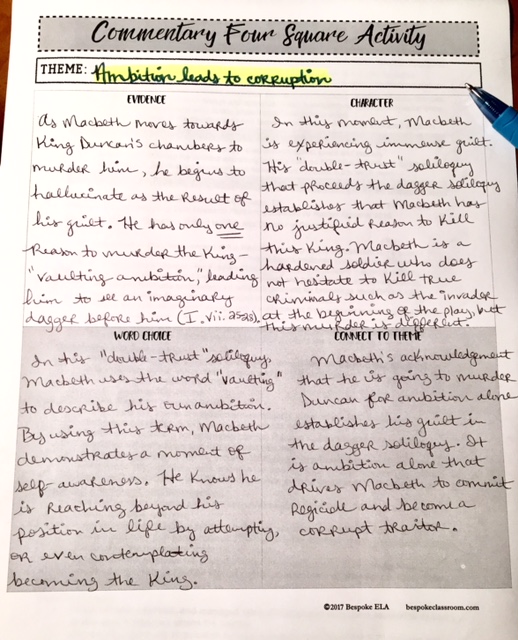Do you ever see something like this when grading literary analysis essays?
“Frankenstein’s monster says, ‘If I cannot inspire love, I will cause fear!’ This shows that the monster wants to cause fear.”
Crafting commentary for literary analysis is one of the most difficult aspects of analytical writing. The reason this writing skill is so difficult for students is because it is the part of literary analysis that contains the original thoughts of the writer. All other aspects of essay writing have standard formulas to follow—except for this one skill. We cannot tell students what to think, and we cannot tell them how to analyze a text. So where does that leave us as teachers? What can we do? How can we help our students go deeper with analysis?
The Four Square Strategy
The Four Square Strategy is a graphic organizer activity that helps students visually map out a “chunk” of writing. Borrowing from “old school” pedagogical vernacular, a “chunk” of text consists of an opinion, evidence, and commentary to explain how it fits together. A body paragraph should, in the traditional sense, contain at least two “chunks” in order to prove the topic sentence and the overarching thesis statement of the essay. The Four Square Strategy can help students piece a “chunk” of text together in order to develop their analytical skills. This activity also gives students two specific entry points to discussing a text: characterization and word choice.
Here’s how the strategy works:
1. Students take a piece of paper and divide it into four squares. They can either do this with a pen or by folding the paper. OR-- click on the image below to download a free template.
I have my students keep their four square activities in their Writer’s Notebooks throughout the school year. At the end of the year, I have them go back and look at how they have developed their analytical abilities over the course of the year.
2. Students write a thematic claim at the TOP of the page. This is the thematic claim that would appear in the thesis statement of the essay.
Example = Ambition leads to corruption.
3. Students then label the four squares as follows:
Top Left = Opinion + Evidence
Students should blend the evidence in the writing if they are able to at this point.
Top Right = Character Comment
In this square, students write 1-2 sentences explaining what the quotation shows about characterization. Every single piece of evidence connects to character—someway, somehow; therefore, students can always comment about character when writing commentary.
Bottom Left = Word Choice (Diction) Comment
In this square, students write 1-2 sentences about specific words in the quotation. These words may contain a specific tone, or they may contain a figurative device such as a metaphor. Students should explain what these words imply beyond the obvious.
Bottom Right = Connect to Theme
This is the part of the chunk where students should explain how character and word choice connect to the theme and prove it.
4. Square Share!
Students share their four squares either with a partner, a small group, or the entire class. It is imperative that students see multiple examples of these chunks in order to expand their realm of commentary possibilities.
5. Rinse and repeat again and again!
The only way for students to become skilled at crafting commentary is through practice, practice, practice… and through seeing example after example. The Four Square Activity is ONE strategy for helping students know what to write about in their sentences for each “chunk” of text.
Click HERE to download a FREE COPY of the Four Square Activity for Crafting Commentary by Bespoke ELA!
And don’t forget to check out the Literary Analysis Mega Bundle by Bespoke ELA that will help you guide your students throughout the entire writing process!
About the Author
Meredith is the founder and creator of TeachWriting.org and Bespoke ELA. She has taught high school English for 10+ years in Dallas, Chicago, and New York City and holds a M.A. in Literature from Northwestern University. She has always had a connection to the written word-- through songwriting, screenplay writing, and essay writing-- and she enjoys the process of teaching students how to express their ideas. Meredith enjoys life with her husband, daughter, and sweet pups.












